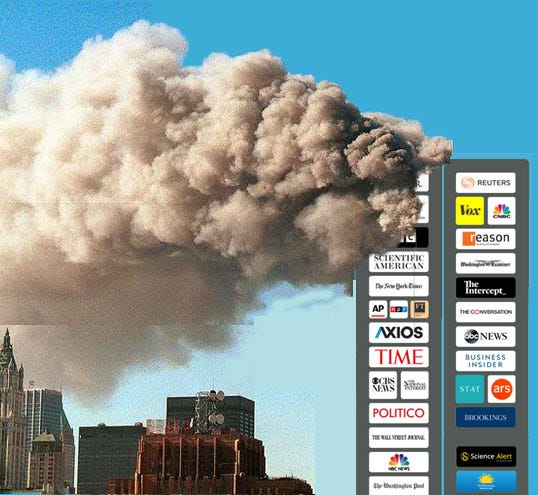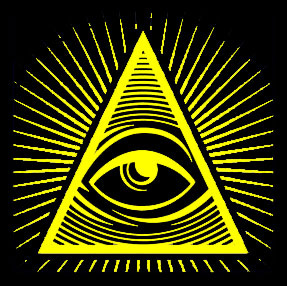Truthsmack #17: The Elusive Art of Neutrality
Plus Ukraine peace deal, Voter fraud
When I got to work on Sept. 11, 2001, the entire newsroom was gathered around the TV monitors off to the side. An airplane had crashed into the World Trade Center and, as we stood glued to the set in utter disbelief, we soon watched a second plane hit the other tower.
Well, it was all hands on deck. Every reporter on every desk (even sports) was assigned to local 9/11 follow-up stories. I interviewed three Middle Eastern businessmen in the wake of arson threats to the local mosque and the verbal assault of a Sikh convenience store owner.
After my lead, my transition graph gave a little context: “Government officials consider ex-Saudi religious extremist Osama bin Laden, who has been suspected in attacks against the United States, the prime suspect.”
Seemed pretty straightforward – just the facts, ma’am. This was written on Sept. 14 and the national narrative around 9/11 had yet to gel. My editor inserted the adjective “terrorist” into the sentence – as in, “suspected in terrorist attacks.”
Back then, newspapers had several protective layers of editing. My page (or line) editor would kick the story up to an assistant managing editor for review. If any questions arose, that editor could kick it up to the managing editor, then to the editor-in-chief. The story would move to the copy desk for further proofing, editing for space and a headline.
I told my page editor (my boss) that I was uncomfortable with inserting the adjective “terrorist” into the graph. It seemed to introduce spin to a story that needed to be neutral. Had terrorists hit the Twin Towers? Was it a military strike by a hostile nation (i.e. Iraq)? Were foreign intelligence agents involved (remember the Israelis arrested in New Jersey after cheering the collapse of the towers)?
My editor insisted, but offered to go to the managing editor for a call. I declined, not feeling strong enough about it to engage in a power struggle with higher-ups.
The next morning, I opened the paper and immediately noticed the word “terrorist” had not been inserted in the final version. I soon learned that the copy desk had removed it on guidance from the editor-in-chief.
This is just one example of how reporters and editors struggle with neutrality, a cornerstone of professional journalism. In an era when jumping to conclusions has become an Olympic sport, neutrality is an elusive art.
Neutrality requires language that doesn’t take a side. People from all sides should be able to read a neutral news story and feel it is accurate and devoid of spin.
According to a Gallup study in July, public confidence in newspapers and television news has plummeted to an all-time low. Only 16 percent of U.S. adults reported "a great deal" or "quite a lot" of confidence in newspapers, and 11 percent in TV news. These dismal readings are down five percentage points from last year.
“Multiple Gallup measures of Americans' views of the news media show a growing distrust,” Gallup claimed. “Last fall, Gallup found near-record-low trust in the media to report the news fully, accurately and fairly, and few Americans rated newspaper and television reporters as highly ethical in Gallup's annual honesty and ethics of professions poll in December.”
The polling didn’t explore people’s reasons for distrust – which could have been more instructive than percentages – but I would submit that for news to be considered “full, accurate and fair,” it must be neutral.
One of my pet peeves these days is the increasing acceptable use of the phrase “Big Lie” to describe Donald Trump’s assertions that the 2020 presidential election was rife with fraud and stolen by the Democrats.
It’s not that I believe Trump’s claims – belief is not the currency of journalism. But, lying implies someone knew the truth and purposely declared something else. This is difficult to prove.
Trump, for example, might sincerely believe the election was stolen from him. He might trust people like Peter Navarro, a really intelligent economist who swears the election was rigged. Or he might just be mistaken. Or is Trump mentally ill (is a panhandling schizophrenic on the median swearing to be Marilyn Monroe’s secret love child lying, or delusional)?
To conclude Trump is telling a “Big Lie” – a phrase coined by Adolf Hitler to describe revising history with a falsehood so colossal the public would have no choice but to believe it – is to assume you can get inside Trump’s head. Mind-reading is for the opinion pages, not news.
Beyond that, using the phrase “Big Lie” in headlines, leads or story copy screams bias. So do adjectives like “baseless,” “debunked,” “disgraced” and “unprovoked.”
For example, in the Daily Beast story on Newt Gingrich’s role in developing pro-Trump ads (pictured above, story here), a Gingrich email is quoted, “The goal is to arouse the country’s anger through new verifiable information the American people have never seen before.”
Nowhere does Gingrich say the goal is to spread lies – clearly the opposite, as he said the ads should feature “new, verifiable information.” Everybody wants that, right? Yet the story’s lead states Gingrich quietly advised Team Trump to “amplify the lie that Donald Trump won the presidential election that year.”
Here’s a fact for you (defined as something no one disputes): polls show that a significant segment of the American people – at least one-third – believe the 2020 election of President Joe Biden was illegitimate. That number pole vaults in a recent poll by the University of North Florida: among Florida Republicans, 77 percent said Trump really won the 2020 election.
And 93 percent of Florida Republicans said the mainstream media is “fake news.”
Back in the context of 9/11, journalists were tempted to use the word “terrorist” before the facts were clear. My first thought watching that dreadful crash into the World Trade Center was – Saddam. A retaliatory guerilla-warfare strike by a hostile foreign power. I’d never even heard of Osama bin Laden in 2001.
We’re still debating how deeply the Saudi royal family was involved – and why. Engineers are still debating how World Trade Center 7 collapsed without an airplane hitting it. And I will defy the skeptics who call 9/11 an “inside job” to get these so-called insiders on the record.
Neutrality is an elusive art and journalists need to practice it if they are to ever regain public trust.
MORE: 9/11’s Unanswered Questions
Ceasefire in Ukraine scuttled behind the scenes
In the current issue of Foreign Affairs magazine, long-time White House Russia advisor Fiona Hill and Angela Stent (Brookings Institution) lay out the conventional narrative for the war in Ukraine – blame it all on Vladimir Putin’s intractable imperialism. However, they dropped an unconventional paragraph that has lots of people raising eyebrows. According to “multiple former senior U.S. officials,” Russian and Ukrainian negotiators hammered out a ceasefire in April. “Russia would withdraw to its position on February 23, when it controlled part of the Donbas region and all of Crimea,” Hill and Stent write. “In exchange, Ukraine would promise not to seek NATO membership and instead receive security guarantees from a number of countries.”
Obviously, this ceasefire and other negotiations never came to fruition. Why not? Ukrayinska Pravda tied it to former UK Prime Minister Boris Johnson’s “surprise” visit to Ukraine April 9-10. Citing unnamed sources from Zelensky's inner circle, Pravda reported that Johnson pressured Ukraine to choose between Europe and Russia, even if it meant extending the war. We need someone to go on the record!
MORE: Ukrainian Calculus – why the war doesn’t make sense
MORE: Ukrainian Alchemy – why the war does make sense
Of Mules and Machines
On Aug. 20, while the rest of America followed headlines about Liz Cheney, the Inflation Reduction Act and Ukraine’s Zaporizhzhia nuclear power plant, MyPillow CEO Mike Lindell was screening his new election fraud documentary, [S]election Code. The film features the story of Tina Peters, the controversial former county clerk in Mesa, Colorado, indicted by a grand jury on 10 charges of tampering with election equipment and official misconduct. In the film, she is a hero who stumbles across evidence of voting-machine manipulation in the 2020 general election. A review will anchor the next issue of Truthsmack. In the meantime, you can read about Dinesh D’Souza’s 2000 Mules, which explores election fraud through the lens of possible trafficking of absentee ballots.
Conspiracy Studies unfold in real-time on Twitter. Follow us at @TruthsmackSaint. Thanks!







